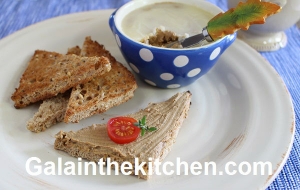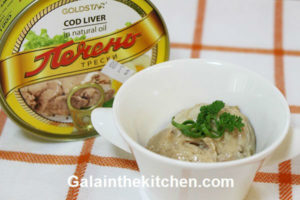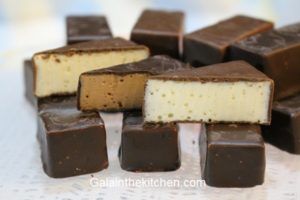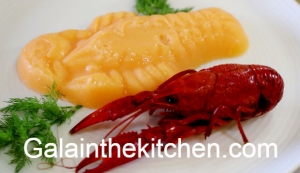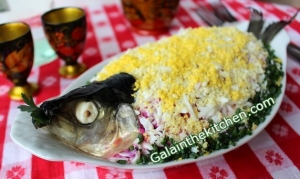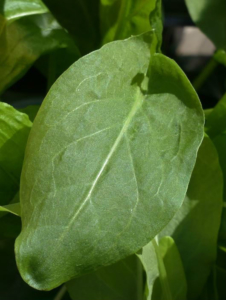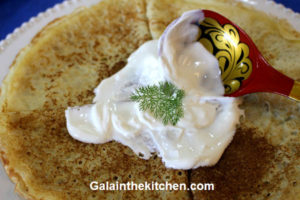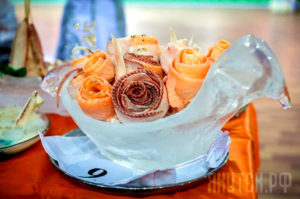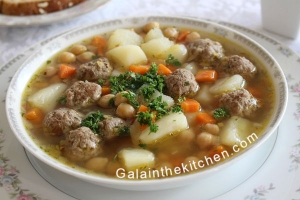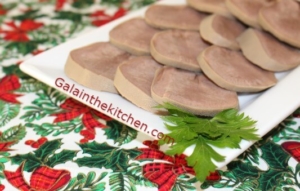Gala’s Russian Food Glossary – P R S T U
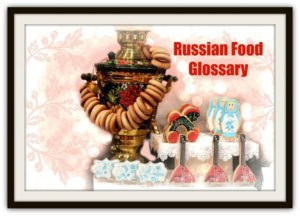
The cooking glossary includes Russian food, cooking terms, ingredients, dishes and our people culinary preferences. The glossary includes photos and pronunciation dishes and ingredients in Russian. The idea to add pronunciation of Russian words to my glossary told my American friend and I hope, it is going to help people. I will continue to add new words and descriptions to my glossary.
How to pronounce
Паштет ( Pashtet )
Pashtet – a type of food in paste consistency. Serve on bread. In Frech cuisine known as pate and should contain liver. However, in Russian cuisine pashtet not necessary contains liver. Pashtet can be made from fish, chicken meat, wild game, mushrooms and much more.
How to pronounce
Печень трески ( Pechen Treski )
Pechen Treski – cod liver. Canned cod liver is a common ingredient for many Russian dishes. We make salads, use as a spread, make stuffed eggs with. Beneficial for health. Available in most Russian stores in the USA.
How to pronounce
Пельмени ( Pelmeni )
Pelmeni – Russian dumplings with grounded meat filling. Can be made with mushrooms, fish, and different meats. Most common recipe mix pork with beef.
Read more 〉 Siberian Pelmeni and Russian Beliefs
How to pronounce
Пирог ( Pirog )
Pirog – a baked case of dough with different fillings. Can be sweet or savory. Can be different shapes and size. In Russian cuisine, it is baked or fried goods. We have a variety of pirog call Kurnik, rastegai, vatrushki, coulibiac and other.
How to pronounce
Пирожки ( Pirozki )
Pirozki ( Piroshki ) – small version of pirog. We make pirozki baked and fried. Pirozki We make with sweet and savory fillings. Pirozki can be stuffed with berries, meat, vegetables, mushrooms and more. Dought can be different too. For example, we make dought with yeast or kefir.
How to pronounce
Пломбир ( Plombir )
Plombir Ice cream – very rich ice cream made from real cream and eggs. Ice cream named after French city Plombieres because this city was famous for extravagant frozen desserts since the late 18 century and the original recipe came from this city. The Russian version of the ice cream was changed from the original French recipe. Plombir ice cream contains butterfat 15%-20% and sugar 15%. Delicious ice cream! Available at stores in Russia.
How to pronounce
Похлёбка ( Pochlebka )
Pochlebka Soup – vegetable soup base on one main vegetable. Like example, potato pochlebka. However, very common you can see on the menu at Russian restaurants meat pochlebka or chicken pochlebka. In some Russian families pochlebka call basic soup.
How to pronounce
Пряник ( Pryanik )
Pryanik – Russian gingerbread made from flour and honey, usually has inside berries jam. It has a unique taste! The most famous is the city of Tula pryanik. We have museums of the history of pryanik at Moscow, Tula and other cities. So many customs and traditions related to this very interesting Russian culinary creation. Tula prianik available in some Russian stores in the USA.
How to pronounce
Пшено ( Psheno )
Psheno – millet grain. Mostly used to make kasha in pumpkin or squash. If you blanch in boiling water before cook, it improves the taste of the product. Very common combination millet porridge cooked in or with pumpkin.
How to pronounce
Птичье Молоко ( Ptichye Moloko )
Ptichye Moloko ( Birds milk candy or cake) – covered with chocolate and flavored with different flavors souffle (chocolate, lemon, vanilla…) can be candy or can be cake. Named from Russian fairy tale. Bird’s Milk means something rear. Recommend to try, very good candies from most companies. Cake can possible to buy only at Russia. Candies available at Russian stores in the USA.
R
How to pronounce
Раковое масло ( Rakovoe Maslo )
Rakovoe maslo– Crayfish butter is infusion from crayfish shells for flavoring dishes. Shells have more flavor than crayfish meat. Crayfish butter well known in old Russian cuisine.
How to pronounce Russian word
Рассольник ( Rassolnik )
Rassolnik Soup – the soup includes pickles, juice from pickles and barley. It can be meat, fish, mushroom or vegetable rassolnik.
How to pronounce Russian word
Ряженка ( Riazenka )
Riazenka – a dairy product made from melted milk by adding sour cream. Consistency like yogurt. Available at stores in Russia.
S
How to pronounce Russian word
Сало ( Salo )
Salo – cured pork lard or pork belly. Most commonly salted or brined. Salo is not only eaten as is usually with potatoes or bread, we use it in many dishes for flavoring and frying potatoes.
How to pronounce Russian word
Самовар ( Samovar )
Samovar – Russian metal beverage jug to heat water to drink tea. An electric version is more popular these days. Originally it was heated from inside by wood and on top placed small cattle to keep the tea warm.
How to pronounce Russian word
Селедка ( Seledka )
Seledka – herring. A very popular fish usually sold pickled or seldom smoked. We eat often pickled herring as a cold appetizer with little vegetable oil, acid, and slices of onion or green onion. A very popular salad called “Herring undercoat” serves mostly on Holidays. The salad is herring layered with chopped (I like shredded) cooked vegetables and cooked eggs. Each layer is covered with mayonnaise. Garnish with ingredients included in salad and green onion or parsley (dill). Pickled herring is available at Russian stores in the USA.
How to pronounce Russian word
Щавель ( Shavel )
Shavel – Sorrel. A very common plant in Russian gardens. Has a slightly pleasant sour taste. Can be eaten as is. Use in soups.
How to pronounce Russian word
Щи ( Shchi )
Shchi Soup – Russian soup with cabbage or sauerkraut (depends on the season) with a wheat flour roux. Shchi can be made with meat, fish or mushrooms.
How to pronounce Russian word
Сметана ( Smetana )
Smetana – Russian sour cream. Very popular in Russian cuisine ingredient. We add to some soups, and dishes, use in baking, making sauces use in baking and much more!
How to pronounce Russian word
Солянка ( Solyanka )
Solyanka Soup – Russian soup, mostly included in restaurant menus than at home cooking because of many ingredients. Very rich in flavors and thick consistency soup. Ingredients are very rich stock, tomato paste, pickles or pickled mushrooms, and a variety of different meat or fish. Garnished with sour cream (for meat), olives, fresh parsley(dill) and lemon without the peel. Solyanka can be meat, mushroom or fish. Very interesting soup to try, if you are going to travel to Russia.
Stroganina – Russian sashimi raw fish dish more known in the North of the country.
How to pronounce Russian word
Сушки ( Sushki )
Sushki – Russian traditional small 2″-3″ in diameter bread in the shape of rings, crunchy and slightly sweet. Very good with tea. Suski is very often garnished with poppy seeds. Very good for long storage. Before baking, they are boiled in water. Available at Russian stores in the USA.
*Baranka is the same just slightly softer than sushka.
How to pronounce Russian word
Суп ( Sup )
Sup – soup. Traditionally we eat soup every day for lunch.
On the photo recipe 〉 Russian Beef Meatball Soup With Chickpeas
How to pronounce Russian word
Сырники ( Syrniki )
Syrniki (tvorozniki) – small pancakes made from tvorog (farmer cheese) and fry in small amount of oil. Serve with sour cream, sweet sauces and garnish with sugar powder. Very common Russian breakfast dish.
T
How to pronounce Russian word
Тархун ( Tarkhun )
Tarkhun – carbonated drink one of popular soft beverages at Russia, name from tarragon plant. A unique flavor. Something slightly close to lemon spearmint.
Tongue beef or calve – delicacy and includes in some restaurant menus in Russia. Serves mostly as a cold appetizer- smoked, cooked, and served with horseradish sauce, in aspic, includes as an ingredient in salads or just part of a meat platter. The tongue is tricky to cook, and needs little experience because if we overcook it, the tongue has a soapy taste.
Check how I cook beef tongue (very important don’t overcook it!) ⇒ How I Cook Beef Tongue Russian Style
How to pronounce Russian word
Топлёное молоко ( Toplionoe moloko )
Toplionoe Moloko – melted milk. Milk bake for hours in an oven. A very popular beverage in Russia. It has beige color and a very nice pleasant taste, good to add to coffee or tea. Use to make other dairy products (riazenka and varenez), cookies, candies, and other baked goods and desserts. Available at stores in Russia.
How to pronounce Russian word
Творог ( Tvorog )
Tvorog – in the USA call farmer cheese. We make so many dishes with tvorog – vatrushki, vareniki, pasha, sweet spreads, use in desserts. We eat as is with honey, sweet sauces, fruits and berries.
U
How to pronounce Russian word
Уха ( Ucha )
Ucha – Russian fish soup. The meaning of dish ucha changed in 2 centuries, word ucha meant any broth and now only mean fish soup. ( Dictionary V. E. Dal )

